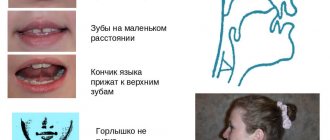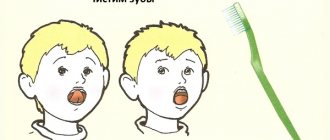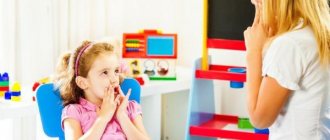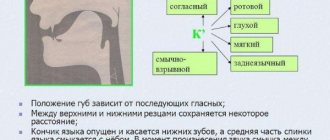Online speech therapy exercises
Speech therapy of vowels:
|
| | | | | | | | | Difficult vowels:
e;e;yu;ya |
e;u;e;y;a;o;e;ya;i;yu | Setting consonant sounds and letters:
|
| | | | | | | | | | | | | | | | | | | Difficult consonants:
b;p | w;w | z;s | g;k | s;ts | v;f | r;l | p;l | r;p;l | z;s;c | h;f;sh;sch;ts;x |
You can use all the speech therapy material provided on the site as a speech therapy aid! Speak words clearly pronouncing letters and syllables. Classes with a specialist and computer programs will help the child improve memory and attention. Articles and exercises from the site () will help you understand whether your child speaks correctly.
The age of the child and the readiness of his speech apparatus
Schematically, a child’s speech development can be divided into stages.
Stage 1. Preparatory
The baby's age is up to 1 year. At this time, an important moment in the baby's development is humming and babbling. At first, sounds appear involuntarily, and by 5 months the child learns to imitate and respond to adults.
Stage 2. Pre-school
Lasts from 1 to 3 years. During this period, children begin to speak in monosyllabic phrases (instead of “Grandma, go,” they say “Baba, di”). Until the age of two, the vocabulary of objects and verbs increases (up to 24 months, the vocabulary is 90-100 words).
After two years, work begins on the quality of speech, and a clear pronunciation of most sounds is formed.
In the pre-preschool period, parents should contact a speech therapist if the child does not put words into short sentences.
Stage 3. Preschool
Lasts up to 7 years. By this age, the child’s active vocabulary includes 3000 words. At 3-4 years old, the baby can still replace some sounds (ts, ch with t), soften consonant sounds.
By the age of 5, softening should pass, whistling and hissing sounds are formed.
By the age of 6, the child learns to pronounce the sounds R and L, and complex, well-constructed sentences appear in speech.
Stage 4
At 7 years old, a child’s speech should be a full-fledged means of communication. Children not only pronounce all speech sounds correctly, but also distinguish them by ear and know how to analyze them. Conjunctions and allied words appear in speech; there are practically no errors in pronunciation. After several comments, the child analyzes the speech and corrects mistakes.
5th period. School
Lasts from 7 to 17 years. At this time, speech, both oral and written, is brought to perfection. The age period from 7 to 9 years is considered critical. This is explained by the fact that after 9 years of age, a child who has no experience of verbal communication becomes unable to learn.
By the age of 11, all phonetic errors in pronunciation disappear.
Staging hissing sounds
Training takes place through classes; methods for producing hissing sounds depend on the diagnosis and the level of psychomotor dysfunction. The principle of an individual approach is used; classes should develop the child emotionally and intellectually. During the production of sounds, visual, auditory and tactile analyzers are connected, motor-kinesthetic, auditory-visual-kinesthetic, and didactic methods are used. Active and passive articulatory gymnastics and massage are performed.
Correct articulation of the sound Ch
When articulating the sound H, the speech apparatus is in the following positions:
- The lips are rounded and moved forward slightly.
- The teeth don't connect.
- The tip of the tongue, without straining, connects with the upper teeth. There should be a small gap between the tongue and teeth.
- There is a flow of air in the middle of the tongue, which is clearly felt when you bring your palm to your mouth.
- The soft palate rises and presses against the back wall of the pharynx, while the passage into the nasal cavity closes, air passes through the mouth.
- The vocal folds do not tense, nor do they move apart.
Diagnostics
If there are sound substitutions in the speech of a child or adult, the diagnosis is based on anamnesis and objective data. The speech therapist conducts a detailed study of speech function, and medical specialists (audiologist, orthodontist) conduct a detailed study of the state of the auditory analyzer and the dental-jaw system:
- Oral speech examination.
It is performed in accordance with algorithms adopted for various speech pathologies (dyslalia, rhinolalia, dysarthria, aphasia). All replaceable and mixed sounds are identified, and the type of defect in the sound side of speech is determined. At this stage, it is necessary to determine what results in sound substitutions: disturbances in speech or physical hearing, articulation difficulties. - Study of the auditory analyzer.
To exclude hearing loss as a cause of sound replacement, an examination of auditory function is necessary. In order to determine the degree of hearing loss, audiometry, acoustic impedance measurements, and auditory EP studies are performed. - Orthodontic diagnostics.
In case of improper closure of the dentition, teleradiography is performed, diagnostic impressions are taken, and photographs of the face and teeth are taken. Based on these data, subsequent treatment is planned.
Setting the sound Ch
The sound Ch can be made in several ways:
- Start by pronouncing the soft sound t. Pronounce it quickly. In this case, the tongue should touch the tips of the upper teeth, then the tongue is slightly curled, as if stroking the bases of the upper teeth. At the same time, the corners of the lips are stretched into a smile.
- Alternately name the sounds t and sh. Do it quickly. At the same time, the lips are stretched into a smile again.
- To find the hole between the teeth from the inside, you can use a piece of paper. First, the hole is felt with your hands, and then paper is applied there. To hold it, you need to apply force - this is an excellent warm-up for the tongue.
How to make the sound "r"
An experienced speech therapist knows how to make the sound “r” for dysarthria, how to make the process of automating the sound “r” interesting. Making the sound “r” with dysarthria can take a long time. After warming up, the doctor asks the child to memorize the words, then repeat them using pictures. The pictures depict objects, flowers, plants, animals whose names contain the sound “r”. Such activities train memory and correct sound pronunciation. Methods used to make the sound “r”:
- Imitation.
- Through articulation.
- Mechanical assistance: from the reference sound, from the articulatory structure.
Articulation gymnastics
It is best to perform all exercises in front of a mirror so that the child can see how he performs them. Each exercise is performed at least three times.
- “Window.” Pull your lips forward as much as possible and give them a square shape. Make sure that the corners of your lips do not touch each other.
- “Pancake.” Smile as widely as possible. Place your tongue on your lower lip, relax and count to 10. The tongue should stretch across the entire width of the lip, but you don’t need to reach it out too far, just enough to cover the lip.
- "Painter". Stretch your lips in a smile, open your mouth slightly, and reach your upper palate with your tongue. Make smooth movements, as if using a brush, from the teeth to the throat.
- “Brushing our teeth.” Smile and make movements with your tongue that imitate brushing your teeth. Be sure to ensure that your tongue reaches the gums and does not run along the bottom edge of the teeth.
- "Cup". Stretch your lips in a smile, stick out your tongue and reach your nose. Remain in position for up to 10 seconds.
- “Delicious food.” Open your mouth and lick your upper lip with your tongue. Movements should be made from top to bottom, not from side to side.
- "Air football" Pull out your lips with a tube. Blow on the cotton wool, but your cheeks should not swell. Blow for 10-15 seconds.
Lip exercises
- “Grimaces of a Clown.” Keep your lips smiling. In this case, the lips should be tense, and the teeth should not be visible. The duration of the exercise is 15 seconds.
- “Fence.” Smile again, but at the same time close your teeth and expose them. Hold the position for 10 seconds.
- “Tube”. Pull your lips into a tube and hold for a third of a minute. The teeth don't connect.
- "Bagel". Round your lips and pull them forward slightly. Hold in position for 15 seconds.
To achieve good articulation, exercises need to be alternated, changing the sequence each time.
Exercises to develop exhalation
- The baby stands with his feet shoulder-width apart. While inhaling, he spreads his arms with his nose, while exhaling, he squats and hugs himself with his arms.
- Starting position is the same as in the previous exercise. Connect your hands in a “lock”, they are at the bottom. As you inhale, your arms rise up, while your breath is held. Then exhale very slowly, lowering your hands and saying “uh.”
- Puff out your cheeks to the maximum, hold for half a minute. Then pull your cheeks in and hold again for the same amount of time.
- Sit on a chair. Slowly lower and raise your hands, saying “Kaar”.
- Game-competition. Children compete to see who can growl the longest in one breath. (You can also compete to see who can hum the longest while exhaling.)
Tongue exercises
Language exercises are divided into static and dynamic.
Static complex:
- "Spatula". Relax your tongue and place it on your lower lip. Stay in this position for 10 seconds (the edge of the tongue should touch the corners of the lips).
- “The point of a needle.” Remove the tongue from the mouth, straighten and tense - the tongue at this time should be even and narrow.
- “Angry cat.” Place the tip of your tongue against your lower teeth and touch the middle of your tongue to your upper palate. Stay in the position for half a minute.
Dynamic complex:
- “Punishment for the tongue.” Stick out your tongue and place it on your lower lip. Press your tongue with your lips and say five-five-five.
- “Watch.” Stick out your tongue and stretch it to one ear, then to the other. Keep the entire speech apparatus in tension.
- “Swing”. Stick out your tongue and pull it alternately towards your nose and chin.
- "Horse". Click your tongue, imitating the blows of a horseshoe. The middle of the tongue is always pressed to the palate.
- "Little Turkeys" Run your tongue back and forth across your upper lip so that you make the sound bl-bl. The speed of movement gradually increases.
Correct articulation
The exercises described above clearly demonstrate that the production of the sound [H] is possible in several ways, which differ in the method of sound production:
1. Use of a reference sound and correct placement of successive movements of the tongue:
- The baby is asked to always pronounce soft [t'] and at the same time concentrate on ensuring that the tongue is tightly adjacent to the alveoli. Then the specialist shows how to curl the tongue towards the larynx from this position. A spatula is used for this. If the isolated sound [t'] is difficult for him, you can replace it with [at'];
- the child is asked to say [t'] and at the same time press the corners of his mouth with his fingers, stretching his lips out like a tube. With this position of the lips, the tongue automatically slides back.
2. Using the effect of merging parts [H]:
- you need to ask the baby to consistently but quickly pronounce the hard voiceless [t], followed by [sch]. At first this is done slowly, and then with increasing tempo of acceleration. It is important that the pronunciation is formed while exhaling.
3. Exercise using a playful form of imitation:
- imitate the chirping of a grasshopper or “call” ducks – “kacha-kacha”;
- read poetry to the child: the adult reads the lines and pauses in those places where the child should utter a sound.
4. Use reference sounds:
- ask to pronounce the sound “t”, focusing on the correct position of the tongue. As the child pronounces, accompany the sound formation with the movement of a bending palm.
It is difficult for a non-specialist to determine which method is suitable for a child. To do this, parents can alternately use each of these exercises. Based on the results of the work, its effectiveness is assessed. The main thing is not to stop at the fact that the child can differentiate the sounds [t'] and [h], because the articulatory skill has not yet been consolidated.
Automation of sound
- Pronounce the sound h, clearly and intermittently.
- Say chchch, extending the sound.
- Game “Catch the Sound”. The adult names different sounds, and the child claps as soon as he hears the sound h. Then the exercise becomes more complicated - the adult pronounces not just sounds, but whole words.
- Game “Repeat”. The adult pronounces sounds, the child repeats them. It is important to ensure correct pronunciation. Example syllables: cha-cha-cha, chu-chu-chu, che-che-che, cho-cho-cho, chi-chi-chi.
- “Counting table.” Count the balls from 1 to 10, and then the keys (one ball, two balls, etc.).
- "Sweet Nothing". The adult says the word, the child calls it in a diminutive form. (Stump-stump, hand-handle, water-water).
- “Complex words and phrases.” Say the words lentil, tap dance, Chukchi, cap, and then phrases - mommy's cap, tea in a cup, Vanya's bunny, Anichkin's ball.
Differentiation of sounds [h]-[t], [h]-[ts], [h]-[sch]
The easiest, but at the same time effective exercise.
Pronounce the following syllables in turn:
| tsa-cha-sha-ta | tso - what - what - that | tsu - chu - schu - tu |
| tsy - chi - cabbage soup - ti | tse -che - more - those | sha - cha - tsa - ta |
| what - what - so - then | schu - chu - tsu - tu | cabbage soup - chi - tsy - you |
| shche-che-tse-those | ats - ach - ash - at | ots - och - oshch - from |
| uts - uch - ush - ut | yats - yach - box - yat | its - ich - isch - it |
| ec - ech - yet - et | ash - ach - ats - at | oshch - och - ots - from |
| ush - uch - uts - ut | box - yach - yats - yat | isch -ich -its -it |
| yet - ech - ec - ut |
Correction
Speech therapy correction
Phonemic disorders that occur in children with physiological dyslalia do not require speech therapy intervention. Correction of pronunciation errors caused by other speech disorders is carried out in the following areas:
- clarification of the articulation of replaced sounds and substitute sounds;
- development of phonemic awareness;
- formation of skills in sound analysis and synthesis;
- development of differentiated perception of speech sounds.
Methods of speech therapy include articulation gymnastics, finger gymnastics, and logomassage. In case of severe pathologies of speech, affecting not only the sound side, but also its other components, work is carried out on all disturbed processes: prosody, voice, vocabulary, grammar, vocabulary, understanding of speech in general.
Medical events
Correction of malocclusion can be carried out using various methods. It depends on the type of disorder, age, and severity of the problem. In preschool age, functional orthodontic appliances and myogymnastics are widely used. In case of permanent occlusion, treatment is carried out with the help of braces, aligners, and, if necessary, orthognathic operations are performed.
Rehabilitation of people with hearing loss is carried out through hearing aids. After selecting and adjusting a hearing aid, such children need classes with a teacher of the deaf and a speech therapist.










